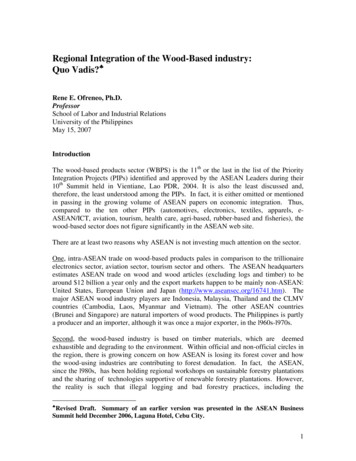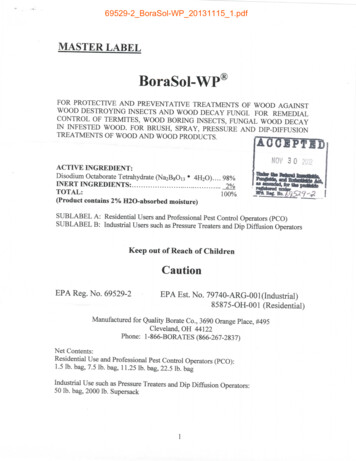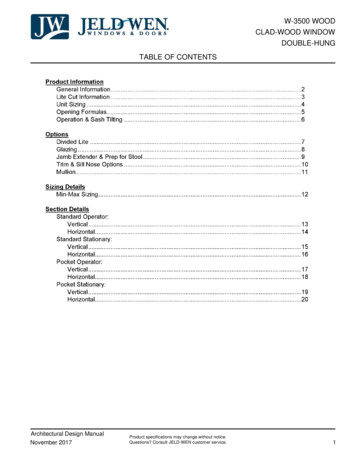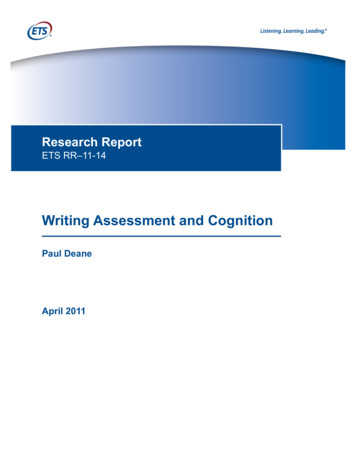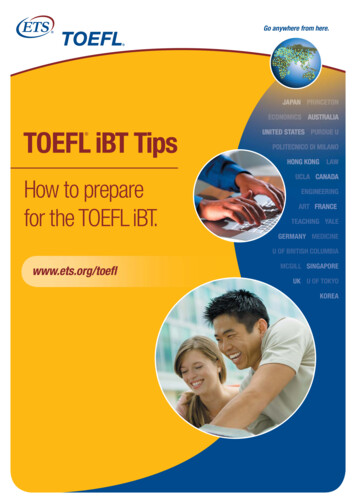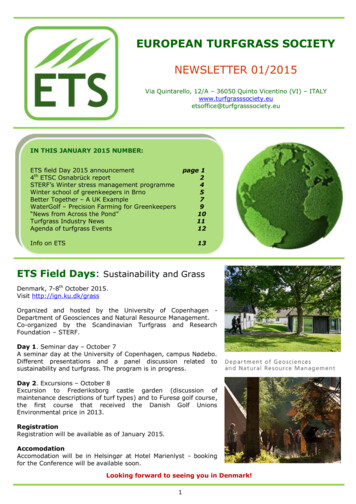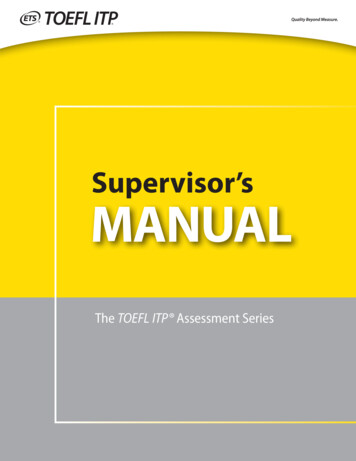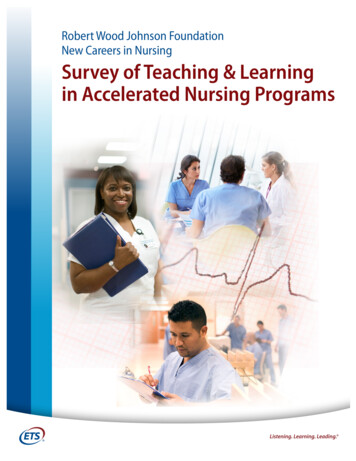
Transcription
Robert Wood Johnson FoundationNew Careers in NursingSurvey of Teaching & Learningin Accelerated Nursing Programs
Survey of Teaching & Learning in Accelerated Nursing ProgramsWe are delighted that you have decided to participate in the Robert Wood Johnson FoundationNew Careers in Nursing (NCIN) Survey of Teaching & Learning. Our aim is to provide new informationon accelerated programs to inform the field of nursing.Participation in the Survey of Teaching & Learning is completely voluntary. You may choose to skip anyquestions you do not wish to answer or to exit the survey at any time without penalty.All responses to this survey will be kept strictly confidential. Completed surveys are submitted directlyto the external evaluator, Educational Testing Service. Results will only be presented in aggregate form.Your responses will not be used in any way that would allow another researcher, foundation official ormember of the public to identify you or your school or college of nursing.Thank you for contributing to this research on accelerated nursing programs. If you have any questionsor concerns about the survey, please feel free to contact the Principal Investigator, Catherine Millett, Ph.D.,at (609) 734-5866 or cmillett@ets.org. Yes, I Agree to ParticipateNo, I Refuse to ParticipateIf select “Yes, I Agree to Participate,” then continue to General Instructions.General InstructionsThis survey is designed to learn about the teaching and learning experiences of students and faculty atyour school or college of nursing. We are asking you to complete the survey on behalf of [FILL: School orCollege of Nursing]. While it is important that you try to provide accurate and complete responses, wehave designed the survey so that you do not need to consult fellow faculty members, program statistics,or other data sources to answer questions.Instead, we ask that you read each question carefully and provide your best response based on yourgeneral knowledge. This may include information gained from teaching courses, advising students,participating in faculty meetings, or having informal conversations with your colleagues.You may leave the survey and return to it later. Survey responses are automatically saved each time youclick continue at the bottom of a page. Please make sure that your Internet options are not set to deletecookies when you close the browser. You will need to use the same computer when you resume thesurvey in order to retrieve previous responses. When you return to the survey, you will have the optionto resume the survey from the last question that you completed or to resume from the beginning ofthe survey.2NCIN Survey of Teaching & Learning in Accelerated Nursing Programs
Nursing Program StructureIn this section, we are interested in learning about the structure of your accelerated program, as well as how itcompares to your traditional programs, if applicable.1.About how many students total are enrolled in nursing programs at your school or college ofnursing? Please provide your best estimate of the number of students at each program level.If your school or college of nursing does not have one of the programs listed below, enter “0” forthat al2.What type of nursing program(s) does your school or college of nursing offer? Please select allthat apply. Associate’s degree (ASN/ADN)Traditional BSNAccelerated BSN (ABSN)GO TO ABSN Section (Q3)RN to BSNBSN to Ph.D.Traditional MSNAccelerated MSN (AMSN)GO TO AMSN Section (Q36)RN to MSNPh.D.DNPDNSOther (please specify):[IF NEITHER ABSN nor AMSN is selected, GO TO Q96]NCIN Survey of Teaching & Learning in Accelerated Nursing Programs 3
ABSNAccelerated Bachelor of Science in Nursing (ABSN) Program3.Aside from program length, what is the primary difference between accelerated and traditionalBSN education?4.Approximately how many students are in your accelerated BSN program (ABSN)?5.What is the time to completion of your ABSN program in months, for the majority of students? 12 months15 months16 months24 monthsOther (please specify):6.What is the pacing of courses in the ABSN program? Please select all that apply. Accelerated courses that are less than 6 weeks longAccelerated courses that are 6-8 weeks longAccelerated courses that are 9-10 weeks longAccelerated courses that are 11-13 weeks longNon-accelerated courses that are 14 weeks or longer7.What is unique about the pacing of courses in your ABSN program as compared with the pacing ofcourses in your traditional BSN program?[ASK IF respondent has traditional as well as accelerated BSN programs.]4NCIN Survey of Teaching & Learning in Accelerated Nursing Programs
ABSN8. How is your ABSN program designed to be completed by students? Accelerated students take a fixed series of courses to complete the program.Accelerated students have the option to select among various courses.9.How does the way in which the ABSN program was designed to be completed compare with thedesign of the traditional BSN program?[ASK IF respondent has traditional as well as accelerated BSN programs.]10. What flexible scheduling options does your ABSN program offer? For each option, select theapproximate proportion of courses offered in that format during a typical academic year.[Items randomized]Clinical Experience0%1–25%26–50%51–75%76–100%Don't KnowEvening coursesWeekend coursesOnline coursesHybrid (both on-siteand online) coursesFlexible clinicalplacement schedules11. If there are other flexible scheduling options available to your ABSN program students, pleasespecify below.NCIN Survey of Teaching & Learning in Accelerated Nursing Programs 5
ABSN12. In your own words, what is unique about the flexible scheduling options in your ABSN programas compared with your traditional BSN program?[ASK IF respondent has traditional as well as accelerated BSN programs.]13. Does your school or college of nursing award bachelor’s-level nursing students credit for evidenceof prior learning (i.e., by examination, portfolios, or other review)? YesGO TO Q14NoGO TO Q1614. In what program(s) does your school or college of nursing award credit for prior learning? Pleaseselect all that apply. We award credit for prior learning in the ABSN program.We award credit for prior learning in the traditional BSN program(s).15. What evidence of prior learning does your school or college of nursing accept for course credit?Please select one option per row.YesTests or examinationsPortfolios of prior learning experiencesOther (please specify):6 NCIN Survey of Teaching & Learning in Accelerated Nursing ProgramsNo
ABSN16 . Does your school or college of nursing blend or combine accelerated students with traditionalstudents in BSN courses?[ASK IF respondent has traditional as well as accelerated BSN programs.] YesGO TO Q17NoGO TO Q1817. In which courses are ABSN students combined or blended with traditional BSN students?BlendedNot BlendedCourse NotOfferedIntroductory courses (e.g., Introduction to ProfessionalNursing, Foundations)Research coursesNursing specialty courses (e.g., Maternity Nursing, Community Health)Leadership coursesEthics coursesDiversity/cultural competency coursesClinical instructionCapstone experiencesInterprofessional electivesCo-curricular seminars or workshopsNCIN Survey of Teaching & Learning in Accelerated Nursing Programs 7
ABSNTeaching StrategiesIn this section, we would like to learn about teaching and learning in the ABSN program, with a focus on uniqueaspects of the accelerated program. We are also interested in how the ABSN program compares with thetraditional BSN program, if applicable.18. Please indicate the importance of each of the following educational goals for students in yourABSN program.[Items randomized]Educational ntialDevelop students’ abilities to think critically1Promote students’ abilities to write effectively2Help students evaluate the quality and reliabilityof information3Help students master knowledge of nursingPrepare students for graduate or advanced education4Prepare students for employment5Help students develop professional identityHelp students develop personal values6Instill in students a commitment to community service7Develop student capacity for leadershipTeach students respect for different beliefs8Enhance students’ knowledge of otherracial/ethnic groups9Develop student skills in management/supervisionDevelop students’ abilities to analyze nursing policy19. In your own words, what is unique about the educational goals for students in your ABSN programas compared with the educational goals for students in your traditional BSN program?[ASK IF respondent has traditional as well as accelerated BSN programs.]1-9HERI Faculty Survey, 2010-2011. Higher Education Research Institute, 2011. 2013 The Regents of the University of California.All rights reserved.8 NCIN Survey of Teaching & Learning in Accelerated Nursing Programs
ABSN20. What proportion of the courses in your ABSN program use each of the following instructionaltechniques?[Items randomized]Instructional TechniquesNoneSomeMostAllDon'tKnowClass discussions10Cooperative learning in small groups11Analysis of practical problems and scenariosDemonstrations12Lectures13Sharing stories about clinical experiencesStudent-selected topics14Individualized instruction/one-on-one attentionDetailed individual feedback on assignmentsReflective writing/journaling15Community service as part of coursework16Electronic quizzes with immediate feedbackInteractive case studiesSimulations of clinical careExplicit learning goals21. What, if anything, is unique about the instructional techniques used in courses in your ABSNprogram as compared with the instructional techniques used in courses in your traditionalBSN program?[ASK IF respondent has traditional as well as accelerated BSN programs.]10 - 16HERI Faculty Survey, 2010-2011. 2013 The Regents of the University of California. All rights reserved.NCIN Survey of Teaching & Learning in Accelerated Nursing Programs 9
ABSN22. During a typical semester, how often do faculty change their approach to teaching in coursescomposed primarily of accelerated — as opposed to traditional — nursing students?[ASK IF respondent has traditional as well as accelerated BSN programs.] NeverRarelySometimesOften23. What proportion of the courses in your ABSN program use each of the following methods toevaluate student learning?[Items randomized]Evaluation MethodNoneSomeMostAllDon'tKnowMultiple-choice exams17Essay exams18Short-answer exams19Quizzes20Simulation exercisesWeekly written assignmentsStudent presentations21Group and team projects to produce joint product22Term/research papers23Student evaluations of each others’ work24Portfolios of student workCompetency-based grading2524. In your own words, what is unique about the methods used to evaluate student learning in your ABSNprogram as compared with the evaluation methods in your traditional BSN program?[ASK IF respondent has traditional as well as accelerated BSN programs.]17 - 25HERI Faculty Survey, 2010-2011. 2013 The Regents of the University of California. All rights reserved.10 NCIN Survey of Teaching & Learning in Accelerated Nursing Programs
ABSN25. During a typical semester, how often do faculty change the type of assignments or tests given incourses composed primarily of accelerated — as opposed to traditional — nursing students?[ASK IF respondent has traditional as well as accelerated BSN programs.] NeverRarelySometimesOften26. What proportion of the courses in your ABSN program use each of the following methods toevaluate student learning?[Items randomized]Instructional TechnologyNoneSomeMostAllDon'tKnowDevelop course websites or other web-based materialsUse learning management systems (LMS)(e.g., BlackBoard, Moodle)Use social media to communicate with studentsModerate online forums for course discussionsAssign exercises and projects that utilizemultimedia resourcesEngage students in collaborative electronic portfolios(i.e., Wikis)Have students keep online journals or blogsFacilitate computer-based patient simulations(e.g., virtual reality)Use smartphones or iPads as clinical toolsUse nursing specialty apps for training or referenceUse simulation labs27. In your own words, what is unique about the use of instructional technology in your ABSN programas compared with the use of instructional technology in your traditional BSN program?[ASK IF respondent has traditional as well as accelerated BSN programs.]NCIN Survey of Teaching & Learning in Accelerated Nursing Programs 11
ABSN28. Please describe your school or college of nursing’s clinical model for the ABSN program by indicatingthe timing of clinical experiences. Select one choice per item.26[Items randomized]Clinical Experience1st halfof nursingcurriculum2nd halfof hedulevaries bystudentNotapplicableObservation of clinical workperformed by othersSimulation skills lab (e.g., IVmedications, handling equipment)Simulations of patient careDirect care of one clientDirect care of multiple clientsManagement of care provided byother studentsManagement of care provided bynursing staff at clinical site29. If your school or college of nursing’s clinical model for the ABSN program includes other clinicalexperiences, please specify and indicate the timing of the experiences below.27Clinical Experience1st halfof nursingcurriculum2nd halfof hedulevaries bystudentNotapplicableOther (please specify):30. In your own words, what is unique about the clinical experiences of students in your ABSN programas compared with the clinical experiences of students in your traditional BSN program?[ASK IF respondent has traditional as well as accelerated BSN programs.]26 - 27Elements of Nursing Education: Program Survey. National Council of State Boards of Nursing, 2004. Copyright by the NationalCouncil of State Boards of Nursing, Inc. All rights reserved.12 NCIN Survey of Teaching & Learning in Accelerated Nursing Programs
ABSNFaculty Roles in Accelerated Nursing ProgramsIn this section, we are interested in learning about the roles and activities of faculty who teach in your ABSNprogram. We would also like to know how faculty roles in your accelerated program compare to the roles offaculty who teach primarily in your traditional program(s).31. Please indicate the extent to which you agree with each of the following statements about facultypreferences for teaching students in bachelor’s-level nursing programs.[ASK IF respondent has traditional as well as accelerated BSN programs.][Items rongly ApplicableDon'tKnowMost faculty prefer teaching traditionalnursing students over accelerated studentsFaculty who teach in the ABSN programprefer that classroom dynamicMost faculty thrive in the classroom withaccelerated students, while others struggleMost faculty prefer teaching master’s and/or doctoral-level nursing students overbachelor’s level studentsFaculty who prefer teaching traditionalstudents rarely change their preferenceFaculty personalities play the primary rolein their preference for either accelerated ortraditional studentsMost faculty have a strong preference foreither traditional or accelerated studentsABSN students are more like master’s-levelstudents than like traditional BSN studentsNCIN Survey of Teaching & Learning in Accelerated Nursing Programs 13
ABSN32. Please indicate whether each statement is more descriptive of faculty who teach primarily in theABSN program or of faculty who teach primarily in the traditional BSN program. Select one choiceper item.[ASK IF respondent has traditional as well as accelerated BSN programs.][Items randomized]Faculty are more likely to Teach on part-time or adjunct basisMaintain a clinical practice while teachingServe as student advisorsHave joined the professoriate recentlyBelong to a group underrepresented in nursingHave tenure or seniority among nursing facultyMeet with students outside of class on a regular basisPromote multicultural perspectives in their instructionUse technology in their instruction14 NCIN Survey of Teaching & Learning in Accelerated Nursing ProgramsAcceleratedBSNTraditionalBSNNodifference
ABSN33. Over the course of the last academic year, how often have faculty who teach in your ABSN programengaged in the following activities?[ASK IF respondent has traditional as well as accelerated BSN programs.][Items randomized]Faculty ActivityNeverRarelySometimesOftenTaught an interdisciplinary or interprofessional course28Taught an ethnic studies course29Taught a service learning course30Taught an exclusively web-based course31Advised student groups involved in service/volunteer work32Collaborated with the local community in research/teaching33Conducted research or writing on issues in nursingEngaged students in research projectsTaught a capstone course34Published op-ed pieces or editorials35Received funding for their work from foundations,government, or business/industry36Supervised clinical experiences34. In your own words, what is unique about the activities of faculty who teach primarily in yourABSN program as compared with the activities of faculty who teach primarily in your traditionalBSN program?[ASK IF respondent has traditional as well as accelerated BSN programs.]28 - 36HERI Faculty Survey, 2010-2011. 2013 The Regents of the University of California. All rights reserved.NCIN Survey of Teaching & Learning in Accelerated Nursing Programs 15
ABSN35. Below are some statements about your college or school of nursing. Please indicate the extent towhich you agree with each of the following:[Items randomized]DisagreeStronglyDisagreeAgreeThe school should hire more faculty dedicated tothe ABSN programThe school of nursing should hire more faculty ofcolor37The school should hire more male facultyThere is a lot of campus racial conflict here38Faculty of color are treated fairly here39Male faculty are treated fairly hereGay and lesbian faculty are treated fairly here40Racial and ethnic diversity should be more stronglyreflected in the curriculum41This school does not allow racist or sexist speech ineducational environmentsThere is too much focus on inclusive language overnursing content these daysEfforts to promote diversity sometimes lead to thehiring of less qualified faculty membersMale faculty have disproportionate influence onpolicies in the school or college of nursing37 - 41HERI Faculty Survey, 2010-2011. 2013 The Regents of the University of California. All rights reserved.16 NCIN Survey of Teaching & Learning in Accelerated Nursing ProgramsAgreeStronglyDon'tKnow
AMSNAccelerated Master of Science in Nursing (AMSN) Program36. Aside from program length, what is the primary difference between accelerated and traditionalMSN education?37. Approximately how many students are in your accelerated master’s program (AMSN)?38. What is the time to completion of your AMSN program in months, for the majority of students? 12 months15 months18 months24 monthsOther (please specify):39. What is the pacing of courses in the AMSN program? Please select all that apply. Accelerated courses that are less than 6 weeks longAccelerated courses that are 6-8 weeks longAccelerated courses that are 9-10 weeks longAccelerated courses that are 11-13 weeks longNon-accelerated courses that are 14 weeks or longerNCIN Survey of Teaching & Learning in Accelerated Nursing Programs17
AMSN40. In your own words, what is unique about the pacing of courses in your AMSN program as com pared with the pacing of courses in your traditional MSN program?[ASK IF respondent has traditional as well as accelerated MSN programs.]41. How is your AMSN program designed to be completed by students? Accelerated students take a fixed series of courses to complete the program.Accelerated students have the option to select among various courses.42. How does the way in which the AMSN program was designed to be completed compare with thedesign of the traditional MSN program?[ASK IF respondent has traditional as well as accelerated MSN programs.]43. What flexible scheduling options does your AMSN program offer? For each option, select theapproximate proportion of courses offered in that format during a typical academic year.[Items randomized]Clinical Experience0%1–25%Evening coursesWeekend coursesOnline coursesHybrid (both on-siteand online) coursesFlexible clinicalplacement schedules18NCIN Survey of Teaching & Learning in Accelerated Nursing Programs26–50%51–75%76–100%Don't Know
AMSN44. If there are other flexible scheduling options available to your AMSN program students, pleasespecify below.45. What is unique about the flexible scheduling options in your AMSN program as compared withyour traditional MSN program?[ASK IF respondent has traditional as well as accelerated MSN programs.]46. Does your school or college of nursing award master’s-level nursing students credit for evidence ofprior learning (i.e., by examination, portfolios, or other review)? YesGO TO Q47NoGO TO Q4947. In what program(s) does your school or college of nursing award credit for prior learning? Pleaseselect all that apply. We award credit for prior learning in the AMSN program.We award credit for prior learning in the traditional MSN program(s).48. What evidence of prior learning does your school or college of nursing accept for course credit?Please select one option per row.YesNoTests or examinationsPortfolios of prior learning experiencesOther (please specify):NCIN Survey of Teaching & Learning in Accelerated Nursing Programs19
AMSN49. Does your school or college of nursing combine or blend accelerated students with traditionalstudents in MSN courses?[ASK IF respondent has traditional as well as accelerated MSN programs.] YesGO TO Q50NoGO TO Q5150. In which courses are AMSN students combined or blended with traditional MSN students?BlendedIntroductory courses (e.g., Introduction to Professional Nursing,Foundations)Research coursesNursing specialty courses (e.g., Maternity Nursing, Community Health)Leadership coursesEthics coursesDiversity/cultural competency coursesClinical instructionCapstone experiencesInterprofessional electivesCo-curricular seminars or workshops20NCIN Survey of Teaching & Learning in Accelerated Nursing ProgramsNot BlendedCourse NotOffered
AMSNTeaching StrategiesIn this section, we would like to learn about teaching and learning in the AMSN program, with a focus on uniqueaspects of the accelerated program. We are also interested in how the AMSN program compares with thetraditional MSN program, if applicable.51. Please indicate the importance of each of the following educational goals for students in yourAMSN program.[Items randomized]Educational ntialDevelop students’ abilities to think critically42Promote students’ abilities to write effectively43Help students evaluate the quality and reliabilityof information44Help students master knowledge of nursingPrepare students for graduate or advanced education45Prepare students for employment46Help students develop professional identityHelp students develop personal values47Instill in students a commitment to community service48Develop student capacity for leadershipTeach students respect for different beliefs49Enhance students’ knowledge of otherracial/ethnic groups50Develop student skills in management/supervisionDevelop students’ abilities to analyze nursing policy42 - 50HERI Faculty Survey, 2010-2011. 2013 The Regents of the University of California. All rights reserved.NCIN Survey of Teaching & Learning in Accelerated Nursing Programs21
AMSN52. What is unique about the educational goals for students in your AMSN program as compared withthe educational goals for students in your traditional MSN program?[ASK IF respondent has traditional as well as accelerated MSN programs.]53. What proportion of the courses in your AMSN program use each of the following instructionaltechniques?[Items randomized]Instructional TechniquesNoneSomeMostClass discussions51Cooperative learning in small groups52Analysis of practical problems and scenariosDemonstrations53Lectures54Sharing stories about clinical experiencesStudent-selected topics55Individualized instruction/one-on-one attentionDetailed individual feedback on assignmentsReflective writing/journaling56Community service as part of coursework57Electronic quizzes with immediate feedback58Interactive case studiesSimulations of clinical careExplicit learning goals51 - 5822HERI Faculty Survey, 2010-2011. 2013 The Regents of the University of California. All rights reserved.NCIN Survey of Teaching & Learning in Accelerated Nursing ProgramsAllDon'tKnow
AMSN54. What, if anything, is unique about the instructional techniques used in courses in your AMSNprogram as compared with the instructional techniques used in courses in your traditionalMSN program?[ASK IF respondent has traditional as well as accelerated MSN programs.]55. During a typical semester, how often do faculty change their approach to teaching in coursescomposed primarily of accelerated — as opposed to traditional — nursing students?[ASK IF respondent has traditional as well as accelerated MSN programs.] NeverRarelySometimesOften56. What proportion of the courses in your AMSN program use each of the following methods toevaluate student learning?[Items randomized]Evaluation MethodNoneSomeMostAllDon'tKnowMultiple-choice exams59Essay exams60Short-answer exams61Quizzes62Simulation exercisesWeekly written assignmentsStudent presentations63Group and team projects to produce joint product 64Term/research papers65Student evaluations of each others’ work 66Portfolios of student workCompetency-based grading6759 - 67HERI Faculty Survey, 2010-2011. 2013 The Regents of the University of California. All rights reserved.NCIN Survey of Teaching & Learning in Accelerated Nursing Programs23
AMSN57. What is unique about the methods used to evaluate student learning in your AMSN program ascompared with the evaluation methods in your traditional MSN program?[ASK IF respondent has traditional as well as accelerated MSN programs.]58. During a typical semester, how often do faculty change the type of assignments or tests given incourses composed primarily of accelerated — as opposed to traditional — nursing students?[ASK IF respondent has traditional as well as accelerated MSN programs.] NeverRarelySometimesOften59. What proportion of the courses in your AMSN program use each of the following instructionaltechnologies?[Items randomized]Instructional TechnologyDevelop course websites or other web-based materialsUse learning management systems (LMS)(e.g., BlackBoard, Moodle)Use social media to communicate with studentsModerate online forums for course discussionsAssign exercises and projects that utilizemultimedia resourcesEngage students in collaborative electronic portfolios(i.e., Wikis)Have students keep online journals or blogsFacilitate computer-based patient simulations(e.g., virtual reality)Use smartphones or iPads as clinical toolsUse nursing specialty apps for training or referenceUse simulation labs24NCIN Survey of Teaching & Learning in Accelerated Nursing ProgramsNoneSomeMostAllDon'tKnow
AMSN60. What is unique about the use of instructional technology in your AMSN program as compared withthe use of instructional technology in your traditional MSN program?[ASK IF respondent has traditional as well as accelerated MSN programs.]61. Please describe your school or college of nursing’s clinical model for the AMSN program by indicatingthe timing of clinical experiences. Select one choice per item.68[Items randomized]Clinical Experience1st halfof nursingcurriculum2nd halfof hedulevaries bystudentNotapplicableObservation of clinical workperformed by othersSimulation skills lab (e.g., IVmedications, handling equipment)Simulations of patient careDirect care of one clientDirect care of multiple clientsManagement of care provided byother studentsManagement of care provided bynursing staff at clinical site62. If your school or college of nursing’s clinical model for the AMSN program includes other clinicalexperiences, please specify and indicate the timing of the experiences below.69Clinical Experience1st halfof nursingcurriculum2nd halfof hedulevaries bystudentNotapplicableOther (please specify):68 - 69Elements of Nursing Education: Program Survey. National Council of State Boards of Nursing, 2004. Copyright by the NationalCouncil of State Boards of Nursing, Inc. All rights reserved.NCIN Survey of Teaching & Learning in Accelerated Nursing Programs25
AMSN63. What is unique about the clinical experiences of students in your AMSN program as compared withthe clinical experiences of students in your traditional MSN program?[ASK IF respondent has traditional as well as accelerated MSN programs.]Faculty Roles in Accelerated Nursing ProgramsIn this section, we are interested in learning about the roles and activities of faculty who teach in your AMSNprogram. We would also like to know how faculty roles in your accelerated program compare to the roles offaculty who teach primarily in your traditional program(s).64. Please indicate the extent to which you agree with each of the following statements about facultypreferences for teaching students in master’s level nursing programs.[ASK IF respondent has traditional as well as accelerated MSN programs.][Items randomized]DisagreeStronglyMost faculty prefer teaching traditionalnursing students over accelerated studentsFaculty who teach in the AMSN programprefer that classroom dynamicMost faculty thrive in the classroom withaccelerated stud
Traditional BSN . Accelerated BSN (ABSN) GO TO ABSN Section (Q3) RN to BSN . BSN to Ph.D. Traditional MSN . Accelerated MSN (AMSN) GO TO AMSN Section (Q36) RN to MSN . Ph.D. DNP . DNS . Other (please specify): _ [IF NEITHER ABSN nor AMSN is selected, GO TO Q96] NCIN Survey of Teaching & Learning in Accelerated Nursing Programs 3
